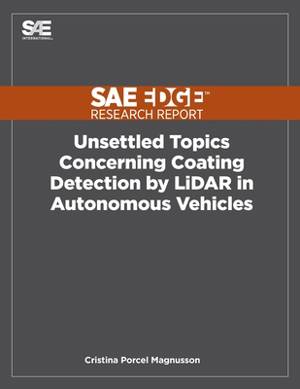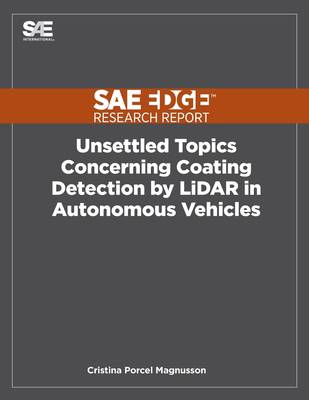
- Afhalen na 1 uur in een winkel met voorraad
- Gratis thuislevering in België vanaf € 30
- Ruim aanbod met 7 miljoen producten
- Afhalen na 1 uur in een winkel met voorraad
- Gratis thuislevering in België vanaf € 30
- Ruim aanbod met 7 miljoen producten
Unsettled Topics Concerning Coating Detection by LiDAR in Autonomous Vehicles
Cristina P MagnussonOmschrijving
Autonomous vehicles (AVs) utilize multiple devices, like high-resolution cameras and radar sensors, to interpret the driving environment and achieve full autonomy. One of these instruments-the light detection and ranging (LiDAR) sensor-functions like radar, but utilizes pulsed infrared (IR) light, typically at wavelengths of 905 nm or 1,550 nm. The LiDAR sensor receives the reflected light from objects and calculates each object's distance and position.
In current vehicles, the exterior automotive paint system covers an area larger than any other exterior material. Therefore, understanding how LiDAR wavelengths interact with other vehicles' coatings is extremely important for the safety of future automated driving technologies.
Some coatings are more easily detected by LiDAR than others. In general, dark colors can absorb as much as 95% of the incident LiDAR intensity, reducing the amount of signal reflected toward the sensor. White cars are more easily detected as they exhibit high IR reflectivity. Many other factors like gloss level, effect pigments, and refinishes can affect reflectivity and even blind LiDAR sensors.
On the other hand, several variables define overall LiDAR and perception system performance, including IR reflectivity of paint but also the target object's geometry, the type of LiDAR technology employed, angle of the target surface, environmental conditions, and sensor fusion software architecture.
Sensing Technologies and Materials are two different industries that have not directly interacted in the perception and system sense. With the new applications in the AV industry, approaches need to be taken in a multidisciplinary way to ensure a reliable and safe technology for the future.
This report provides a transversal view of the different industry segments from pigment and coating manufacturers to LiDAR component and vehicle system development and integration, and a structured decomposition of the different variables and technologies involved.
NOTE: SAE EDGE Research Reports are intended to identify and illuminate key issues in emerging, but still unsettled, technologies of interest to the mobility industry. The goal of SAE EDGE Research Reports is to stimulate discussion and work in the hope of promoting and speeding resolution of identified issues. These reports are not intended to resolve the challenges they identify or close any topic to further scrutiny.
Specificaties
Betrokkenen
- Auteur(s):
- Uitgeverij:
Inhoud
- Aantal bladzijden:
- 42
- Taal:
- Engels
Eigenschappen
- Productcode (EAN):
- 9781468602838
- Verschijningsdatum:
- 18/01/2021
- Uitvoering:
- Paperback
- Formaat:
- Trade paperback (VS)
- Afmetingen:
- 216 mm x 279 mm
- Gewicht:
- 154 g

Alleen bij Standaard Boekhandel
Beoordelingen
We publiceren alleen reviews die voldoen aan de voorwaarden voor reviews. Bekijk onze voorwaarden voor reviews.











